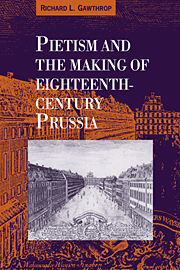Book contents
- Frontmatter
- Contents
- Preface
- Introduction
- 1 The German territorial state in the sixteenth and seventeenth centuries
- 2 Reformed confessionalism and the reign of the Great Elector
- 3 The nature of the pre-1713 Hohenzollern state
- 4 Lutheran confessionalism
- 5 Spenerian Pietism
- 6 From Spener to Francke
- 7 Halle Pietism I: ideology and indoctrination
- 8 Halle Pietism II: growth and crisis
- 9 Pietist–Hohenzollern collaboration
- 10 The impact of Pietist pedagogy on the Prussian army and bureaucracy
- 11 Civilian mobilization and economic development during the reign of Frederick William I
- Conclusion
- Bibliography
- Index
10 - The impact of Pietist pedagogy on the Prussian army and bureaucracy
Published online by Cambridge University Press: 14 October 2009
- Frontmatter
- Contents
- Preface
- Introduction
- 1 The German territorial state in the sixteenth and seventeenth centuries
- 2 Reformed confessionalism and the reign of the Great Elector
- 3 The nature of the pre-1713 Hohenzollern state
- 4 Lutheran confessionalism
- 5 Spenerian Pietism
- 6 From Spener to Francke
- 7 Halle Pietism I: ideology and indoctrination
- 8 Halle Pietism II: growth and crisis
- 9 Pietist–Hohenzollern collaboration
- 10 The impact of Pietist pedagogy on the Prussian army and bureaucracy
- 11 Civilian mobilization and economic development during the reign of Frederick William I
- Conclusion
- Bibliography
- Index
Summary
THE COMMON SOLDIERS
Although Frederick William had made most of the day-to-day decisions in his father's government since the coup of December 1710, he did not have the freedom to carry out his own policies until the death of Frederick I in February 1713. When Frederick William I ascended the throne, he was already quite familiar with the inner workings of state institutions and had no doubts about the necessity of completely overhauling them. Frederick had hardly been buried, therefore, when Frederick William began to put his radical plans into effect. In order to increase the overall size of the army while simultaneously eliminating from it men of smaller physical stature, Frederick William I instituted a drastic policy of forced recruitment throughout the kingdom. Impressment gangs seized tall and strong young men from peasant households, merchants’ stores, artisans’ shops, and university lecture halls. Through such arbitrary methods, Frederick William I increased the size of his army by nine thousand men in 1713 alone, and the pace of recruitment slackened only marginally in the next several years.
Assembling this much larger army was only the first step. Frederick William knew that to compete with the still larger armies of Europe's major states his own forces had to be qualitatively superior in discipline, tactical maneuverability, and fire power.
- Type
- Chapter
- Information
- Pietism and the Making of Eighteenth-Century Prussia , pp. 223 - 246Publisher: Cambridge University PressPrint publication year: 1993



